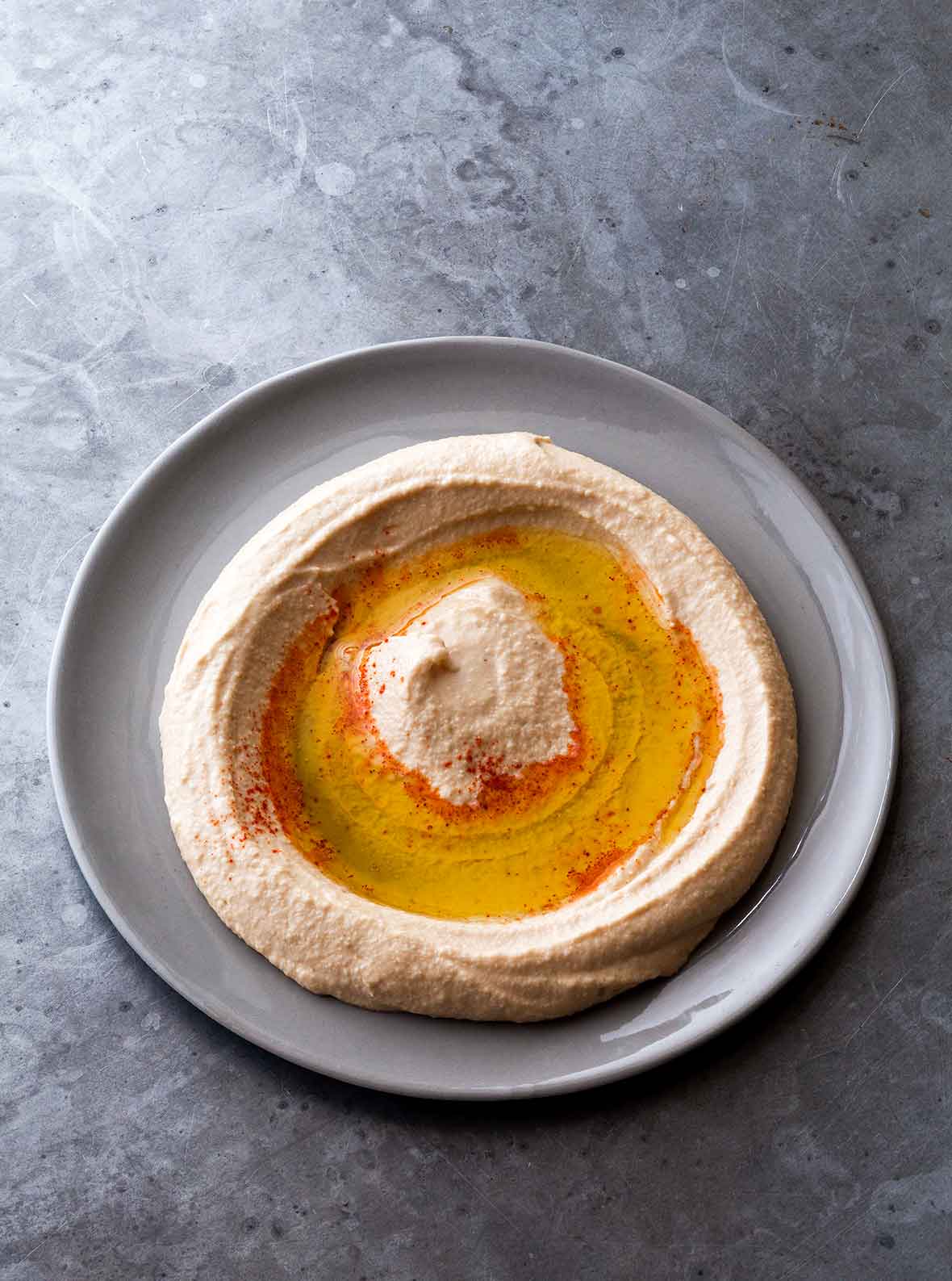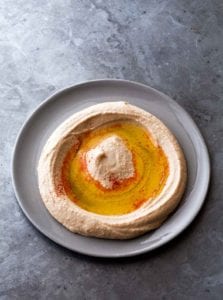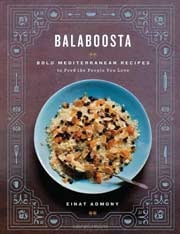
Let’s talk about hummus for a moment, shall we? Specifically, let’s talk about many Americans’ notion of hummus. Some Americans like it plain, whereas others like it for what’s added to it, whether red bell peppers or black beans or Cool Ranch Dorito flavoring. Not that there’s anything wrong with that. But let’s be clear about what it is and what it ain’t. Hummus, as it’s made in the Middle East, is simple. Not fancy. No fireworks. Understated. A subtle sort of beauty. In fact, we’re so taken with it that while the author, Einat Admony, founder of the mad-crazy-popular falafel bar Taïm in Manhattan, refers to this recipe as “my hubby’s hummus,” we prefer to refer to it as “hubba hubba hummus.” It’s that good.–Renee Schettler

Homemade Hummus
Ingredients
- 1 1/2 cups dried chickpeas or three 14 1/2-ounce (415-g) cans chickpeas
- 1 3/4 teaspoons baking soda, (if using dried chickpeas)
- 1 large garlic clove, finely chopped
- 3 tablespoons tahini, (I prefer the White Dove brand)
- Generous 1 1/2 to 2 tablespoons fresh lemon juice
- 2 tablespoons mild-flavored olive oil
- 3/4 teaspoon kosher salt, or more to taste
- 1/4 teaspoon ground cumin
- Pinch freshly ground black pepper
- 1/8 teaspoon sweet Hungarian paprika, for garnish
Instructions
- If using dried chickpeas, dump them in a large bowl and add 3/4 teaspoon baking soda. Add enough cold water to cover and let soak overnight at room temperature. Drain the chickpeas and transfer them to a large pot with enough water to cover. Add 1 teaspoon baking soda and bring to a boil. Continue to boil until the chickpeas are tender, 30 to 45 minutes. (You may want to check the chickpeas for doneness after 10 to 15 minutes as the cooking time can vary dramatically depending on the chickpeas' age and size.) Skim off any floating shells. Drain the chickpeas, reserving 1 cup cooking liquid, and let the chickpeas cool completely. If using canned chickpeas, drain and rinse the chickpeas and continue below.
- Combine the drained chickpeas, garlic, reserved liquid if using dried chickpeas or 1 cup cold water if using canned chickpeas, tahini, lemon juice, 1 1/2 tablespoons olive oil, salt, cumin, and pepper in a food processor and purée until smooth and creamy. Plop the hummus on a plate or in a shallow bowl. If desired, cover and refrigerate it for an hour or so or for no more than a day.
- When ready to serve, drizzle with the remaining 1/2 tablespoon olive oil and sprinkle with the paprika.

Nutrition
Nutrition information is automatically calculated, so should only be used as an approximation.
Recipe Testers’ Reviews
There are many recipes for Middle Eastern hummus, and many are quite fine. And then there is this recipe. Don’t even think of not trying this recipe. It’s absolutely divine. This recipe is spot-on. This resulted in the most wonderfully silken, smooth, delicate, subtle, fantastic hummus. The spices were perfectly proportioned.
I would use more lemon next time—I used a Meyer lemon from my tree, and while it is really good as is, I think a bit more pop from the citrus would send this off the charts. I used two 19-ounce cans and one 15-ounce can of chickpeas. I used a full cup of the reserved liquid from the chickpeas and it made this just perfect. I’m now trying to think of all the ways I can use it besides with pita, chips, veggies, and fingers!
Hummus is basically the same the world over, but this version was an irresistible winner in our book. In addition to smearing it on pita, we enjoyed it with carrot strips, celery, and snow peas for dipping. I used 3 cans beans, and I reserved 1/2 cup liquid when I drained and rinsed the beans. I used all the bean liquid. I increased the lemon juice to 2 1/2 tablespoons because we like that citrusy tang. I covered and refrigerated it for a day and that seemed to blend the flavors even more. I toasted some sesame seeds and topped the hummus with them before drizzling the last of the olive oil on top. I’ll keep this recipe handy for the next game day at our house.
The consistency of this hummus was splendid. The balance of all the flavors worked well. I use it in place of mayo and as a condiment.
I ordinarily don’t make hummus, as we can buy such delicious store-bought stuff here in Israel. However, after trying this recipe, I’ll be making my own from now on. It was perfect. I used dried chickpeas and got 3 1/3 cups—there was probably more like 3 3/4 to 4 cups, but I couldn’t stop tasting it. I also left mine a little chunky because that’s the way we like it. Other than that, I wouldn’t change a single thing about this recipe. It’s a winner.
I served it immediately and the remainder went into the fridge—covered, of course. I was thrilled with it the first day. The second day it had lost its beautiful texture and wasn’t as good.
This is a goooood hummus. We don’t have a food processor, so we just smashed everything together with a potato masher—it was easy to put together and delicious. After the first round of tasting, we ended up adding more lemon juice because we all love it. Everyone agreed it had very good flavor. I loved the fresh garlic kick.
This is really good and really easy. I really like this recipe because it’s flavorful enough to eat on its own, but it welcomes mix-ins as well. I mixed a scoop with finely chopped roasted red peppers and another scoop with finely chopped olives. Fab. I didn’t even bother chopping the garlic—I just tossed it in the food processor and blitzed it until it was finely chopped. (I used 2 cloves of garlic.)
The flavors were fine right away, but a few hours in the fridge didn’t hurt at all. I prefer it at room temperature rather than chilled. Since it makes so much, I’ve been sneaking it onto sandwiches and I was tempted to whizz it into a smoothie but I stopped short. I’ll probably only make this hummus when I know I’ll feed a crowd since it makes so much.
Armed with a snow storm and a bag of dried chickpeas, I decided to give this recipe a try. I’d already made the leap from store-bought hummus to homemade using canned chickpeas, and I was anxious to see if soaking my own chickpeas would result in a better version. The answer is a definite yes. I’d never made beans with the addition of baking soda, and they were tender and creamy when done. (I must admit that I’d actually overcooked them, but I wasn’t worried since they were getting puréed anyway. I probably should have started checking them at 30 minutes.)
As for the floating shells, there were tons of shells, though not quite floating. I got rid of as many as I could, but many just clung to the beans so I just left them. It was the creamiest, freshest tasting hummus I’d ever tasted. I ate some and then opted to refrigerate the rest. As for the tahini, I used what I had on hand, but I’ll look for the White Dove brand in the future—I’m wondering if there is truly a difference between brands. At room temperature, this was a bit looser than I’m accustomed. I think that next time I’ll start with less cooking liquid and then will add more as needed.
This is delicious chilled and could surely be served either way. I can think of tons of uses for it, and next time I might even try flavoring it with some cayenne pepper. I know what I’ll be serving for happy hour tonight. P.S. So here I am, 24 hours later, with a lot more to say about this recipe. It was definitely better just after having made it—it was creamier, more flavorful, and altogether a better product. It’s still a great product, and I’m dipping carrots into it as we speak (and I think I must go open a bottle of wine…). It seemed like the beans absorbed all of the flavors, and it just needed a bit more of everything. I put it back in the food processor and added more of all of the spices. This time around I also threw in a bit of cayenne pepper. I think that the super creamy, smooth texture is best appreciated right after it’s prepared.
I enjoy a good hummus, and I shake my head at myself every time I find myself buying it at the store. It’s so cheap and easy to make! This recipe was especially easy since I went the canned chickpea route. I added a little more cumin and garlic than was called for after sampling it, but otherwise I followed the recipe exactly. The consistency was perfect. My 19-month-old was going at it with a spoon. I drizzled olive oil over the top and sprinkled it with pine nuts and some chopped tomatoes. It made for a tasty appetizer. No complaints about this healthy snack!
The chickpeas were perfect and velvety in texture, but the overall flavor came off as a little tame.
The choice of olive oil will definitely affect the end result. I tried this recipe as is, and it’s pretty good if you like a smooth, relaxed chickpea experience. However, I really wanted more of a “whole flavor” extravaganza. A rich, buttery, frutatto olive oil seemed to mask the flavors, so I’d recommend trying to get an olive oil that has a somewhat peppery flavor, with a leafy greens aspect to it. I also found that adding more tahini, lemon juice, salt, and cumin really perked the hummus up. At that point, the other flavors began to pop enough to really appreciate them. I found that adding an extra 1/2 tablespoon each lemon juice and tahini, 1/4 teaspoon ground cumin, and salt really made a difference between “okay” and “hey, this is good stuff!”















This one was a bit of a flop for me, though there may have been some user error involved, because everyone else seems to have loved it. Usually I simmer beans rather than boil them, but, following the recipe, I kept them at a boil for 45 minutes, thinking a very tender bean was what the recipe was going for. This resulted in very mushy chickpeas that were falling apart, but I wasn’t worried because they were going to be mashed up, anyway. I think this and not seeing the bit about letting them cool completely may be where I went wrong, because I measured everything else carefully and my result was decidedly soupy in consistency and not particularly tasty. If I make this again, I’ll won’t cook the beans so long, I’ll let them cool completely, and add only a little water.
M, I’m so sorry this didn’t work for you. It always bothers me when a recipe we all love and know works doesn’t turn out for a reader. I always ask myself, “Is there something that we missed?”
If you do decide yo make this again, I’d suggest changing only one thing: say, cooling the beans completely. Otherwise you might swing in the other direction and have a problem.
Try drizzing Meyer Lemon Olive Oil on it…. amazing. ( I make it without Tahini )
Sounds amazing, Randi.
What I learned in Israel leaves out the salt and pepper, uses olive oil, and, when preparing the tehina, we added dill.
Something to remember when using the food processor…make sure to keep adding liquid or it turns into a solid block of cement and destroys said processor rather efficiently.
A nice side with the hummus and pita is pickled veggies…pickles, pickled turnip, pimento…..it’s nice.
freya946, thanks for all the tips. I think you may have single-handedly prevented a few food processors from biting the dust.